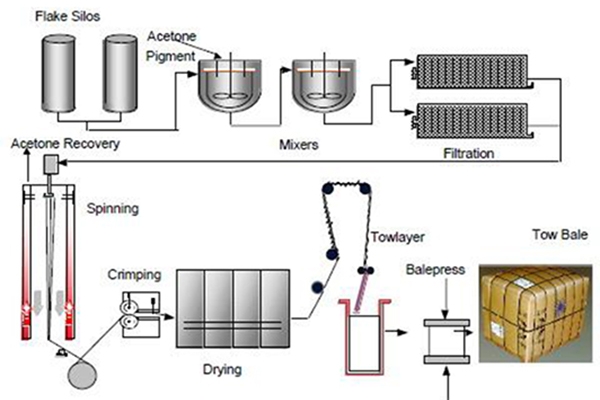Acetate Tow is produced by reacting high purity wood pulp with acetic anhydride. The acetate flakes that are produced through this chemical reaction are dissolved in a solvent, filtered, and adjusted to obtain spinning stock solution. The spinning stock solution is extruded through controlled nozzles with extremely small pore diameters ranging from 30 to 50μm. The solvent is then evaporated, and the yarns are formed. This process for producing acetate tow is known as the dry spinning method. The cross-section of acetate tow is called a “chrysanthemum,” and is shaped uniquely with many lobes. After the spinning stock has been extruded through the pores, it takes on a round-shaped cross-section. However, rapid evaporation of the solvent from the surface results in the formation of a skin layer on the surface of the fiber. After that, evaporation of the solvent from the inside of the fiber causes the skin layer to cave in toward the fiber cross-section, giving rise to the final multi-lobal cross-section.

The production of cigarette filter tow can be described in four principal steps.
Step 1: Preparation of the spinning solution
Cellulose acetate flakes and acetone are mixed together intensively. A small amount of titanium dioxide is added as a delustering agent for the later product. To achieve a spinning solution free of particles able to block the spinnerets, the mixing is followed by an intensive filtration.
Step 2: Spinning
After passing the spinneret of a spinning cell the acetone starts to evaporate from the spinning solution. The evolving filaments solidify and are brought together while the acetone is almost completely removed and recovered.
Step 3: Crimping
The resulting filaments from numerous spinnerets are combined to form a cable of up to several tens of thousands of filaments. These cables are subsequently crimped in a stuffer box to obtain the typical cigarette filter tow structure.
Step 4: Drying and processing
The fresh crimped structure is fixed by drying, and the cigarette filter tow is compressed in bale presses to form filter tow bales.